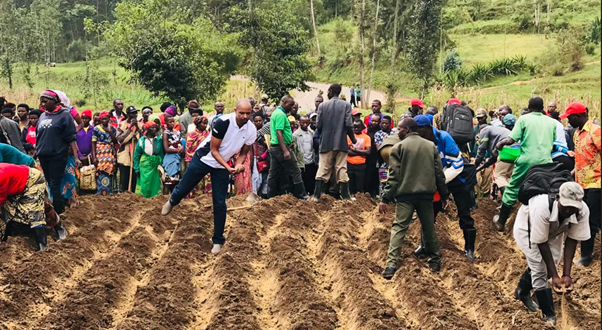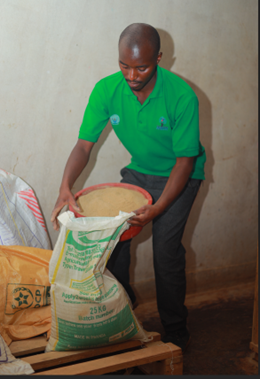
On a field day in Gatsibo District, Eastern Province, Pascal Twizere (r), the Managing Director of MULIMECO, showing a farmer (l) the best practice for applying grade one lime to the soil.
Rwanda’s farmers have long struggled to obtain quality lime to improve their soil for better crop productivity. The most common lime available was unprocessed, requiring large quantities – of between 2.5 and 4 metric tons (mt) per hectare, and it had to be applied at least two months before planting. Additionally, distribution networks were inadequate, making it difficult for farmers to access the lime on time. The lack of awareness further compromised adoption.
The introduction of machinery for processing lime, supported by the Alliance for a Green Revolution in Africa (AGRA), has revolutionized the lime value chain in Rwanda. This technology produces ‘lime grade one’, which is of a higher quality and easier to apply than the previously used ungraded lime. The application rate of lime grade one is significantly reduced, requiring between 750 to 1500 kilos per hectare, depending on soil type and quality. This advancement has not only simplified the application process; it has also made it more cost-effective and profitable for farmers.
For this reason, the Great Lakes Accelerated Innovation Delivery Initiative Rapid Delivery Hub (AID-I GLR) entered into a partnership with AGRA, leveraging AGRA’s previous investments in lime processing to address soil acidity, and visibly transform agriculture in Rwanda.
One of AGRA’s significant investments was supporting MULIMECO, a lime grade one processing company in Musanze District, Northern Province. With AGRA’s financial support, MULIMECO acquired a lime-processing unit to produce lime grade one, ensuring a higher quality and effectiveness. This lime was then distributed through a newly established channel involving local agro-dealers.
“For Rwanda’s acidic soils, this partnership with AGRA has been a game-changer in improving and promoting the integrated use of quality lime and nutrient-blended fertilizers for sustainable agricultural productivity, soil health, food security, and income of smallholder farmers,” revealed MULIMECO’s Managing Director, Pascal Twizere.
MULIMECO’s efforts to promote awareness and farmers’ adoption of lime grade one include setting up demonstration plots in acidic soil zones. Farmer Promoters (a volunteer extension agents’ group at village level) lead these demo plots, where they showcase the benefits of using high-quality lime. MULIMECO also organized farmer field days to educate farmers on the advantages of using lime grade one, providing small packs of seeds and lime for testing in their plots. The live demos spurred requests for lime grade one, thereby igniting business relations between MULIMECO and the agro-dealers, which improved access and availability of lime grade one.

June 2024: Farmers in Gatsibo District learning the lime grade 1 application methods and related good agronomic practices.
Valentine Dusengimana of Rulindo District, Northern Province, experimented with lime grade one on her Irish potatoes and beans plot. She observed significant improvements: “For my Irish potatoes, the harvest increased from 350 kilos in season 2023 C to 1 metric ton in season 2024 A. This encouraged me to and buy more lime to grow Irish potatoes in season 2024 B. Beans are also benefiting from the effect of lime applied last season. We were advised to apply lime every two seasons it has helped the beans, and it is looking good in the field, even though the sun had come earlier than usual. Many of the crops that the lime grade one had not been applied to, especially the beans on my colleagues’ farms who did not apply the lime grade one and the good agronomic practices, are not performing well; they have started to dry up. However, I expect a good yield because I used lime grade one and other good agronomic practices,” she explained.
Valentine’s experience is echoed by many other farmers who attended the field days and tried the lime on their plots. Encouraged by the positive results, farmers have returned to agro-dealers to purchase more lime for larger plots. One agro-dealer reported an increase in demand, from
300 farmers in season 2024 A to 1,200 farmers in season 2024 B, with numerous farmers returning for more lime grade one after seeing its benefits.
“The demand for lime grade one has grown. Previously, I would bring 5 Tons of lime to sell in my shop per season, but now, I can sell up to 20 Tons in one agricultural season,” reported Jean Claude Nshimiyimana, an agro-dealer in Rulindo District.

Valentine Dusengimana, a farmer in Rulindo District, admiring the improved condition of beans after using lime grade 1.

Jean Claude Nshimiyimana, an agrodealer in Rulindo District, weighs lime grade 1 in his shop for sale to farmers.
The success of this initiative is a testament to the power of high-quality agricultural inputs and community-driven awareness programs, as evidenced by returning customers driven by good product performance.
By ensuring the availability of lime grade one through local agro-dealers, MULIMECO has not only improved individual farmers’ yields but also enhanced the sustainability of the lime value chain in Rwanda. Most importantly, in the long run, the initiative will contribute to restoring the health, wealth, and well-being of Rwandan soil.
In this short video, Jean Claude, the agro-dealer, and Valentine, the farmer, describe their experience with lime grade 1:

No Comments